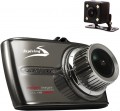Processor
Model of the processor used in the dashcam
The term "video chip" is used mainly for devices with classic capabilities, "processor" — for advanced models with an abundance of non-standard functions. However, anyway, we are talking about the same component — the main computing unit, the characteristics of which directly affect the capabilities of the recorder as a whole. Knowing the model of the processor, you can find detailed data on it and evaluate how satisfied you are with a device based on such electronics. Of the most advanced modern chips, one can name, in particular,
Ambarella A7L,
Ambarella A12,
Novatek NTK96655,
Novatek NTK96660 and
HiSilicon Hi3516.
Viewing angle
Viewing angle of the additional dashcam camera. Depending on the design and configuration, it may refer to either an external camera or an interior camera (see above for both); this nuance should be clarified separately. The viewing angle can be specified both horizontally and diagonally, which is why models with the same figures in the specifications may slightly differ in their actual field of view. However, in this case, this difference is not critical.
In theory, a wider viewing angle allows for capturing a larger area, but individual details in the frame become smaller. Additionally, wide-angle lenses can cause geometric distortions at the edges of the image; the DEWARP technology (see "Features") used to eliminate them is usually not used in additional cameras.
Touchscreen
Touch screen similar to those used in smartphones and tablets. Control by touching the icons on such a display often turns out to be more convenient and intuitive than through the classic buttons, and sometimes it is simply irreplaceable — for example, it is very convenient to mark points on the map with a touch when using a GPS navigator (see "Functions"). On the other hand, such screens are more expensive than usual ones, and it makes sense to use them mainly in advanced registrars with an abundance of additional features.
Note that there are other specific types of control in registrars —
voice control and
gesture control. They are not as functional as touch ones, but they are noticeably safer when used while driving; see "Functions" for details.
HDMI
HDMI port is an output that allows you to use the recorder as an external player — namely, to broadcast video and audio from it to a TV, monitor or other video equipment that has the appropriate input. The HDMI standard is specially designed for high-definition content, it allows you to transfer even the highest quality video (up to and including UltraHD 4K); and inputs of this type are available in almost all video devices that support HD standards — in particular, in the vast majority of modern TVs. Note that a smaller version of the HDMI connector is usually installed in the recorder, and the appropriate cable is supplied in the kit, but the presence of the latter needs to be specified separately.
Max. memory card size
The largest size of the memory card allowed for the device. This limitation is primarily due to the fact that more powerful hardware is required to work with larger volumes. In addition, there are nuances associated with individual subspecies of cards. Anyway, this value cannot be exceeded: with a high probability, the registrar will either work incorrectly, or will not be able to work at all, or even completely fail.
Most modern registrars support cards
up to 32 GB or
64 GB, but there are models that are compatible with more capacious cards —
128 GB or even
256 GB.

